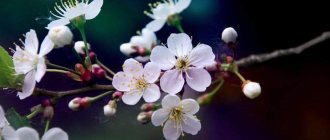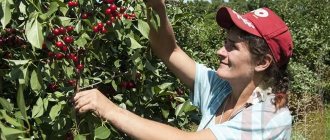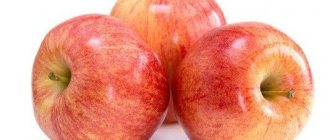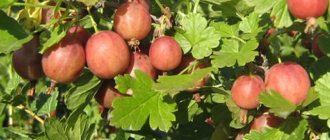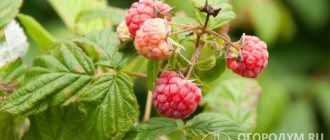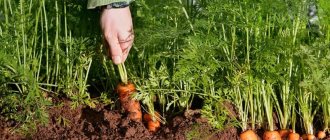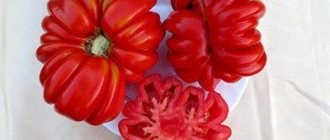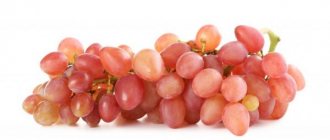Cherry Fairy: description of the variety
Felt cherry Fairy: photo of the variety
The Fairy cherry variety tree is small in size, reaching from two to three meters. The branches are strong, durable, slightly raised, the crown has the shape of a ball. The foliage is large, dark greenish in color, and the cuttings are red.
The buds are snow-white. The fruits of the Fairy cherry are pinkish in color, weighing about three and a half grams, but it happens when the fruit reaches four grams. The berry is round in shape, slightly elongated. The contents inside are light pink, tender, juicy. Fairy felt cherry berries are sweet with a hint of sourness. In terms of taste it gets four point three points. The fruit stem is small in size and not wide.
Felt cherries of the Fairy variety are recommended to be planted in the Central Black Earth Region.
Description of culture
Fairy cherry forms a low tree that grows up to 2-3 m. The branches of medium thickness and density form a raised spherical crown. The elliptical, dark green leaves are not large in size; they are attached to the shoots with reddish petioles.
White large flowers turn into pink one-dimensional fruits. Their size is average - only 3.3-3.5 g, rarely - up to 4 g, shape - round, slightly elongated. The pulp of the Fairy cherry is pinkish-yellow, tender, with a lot of juice. Tasting assessment of sweet and sour fruits – 4.3 points. The peduncle is short, of medium thickness.
The Fairy cherry variety is recommended for cultivation in the Central Black Earth region.
Cherry Fairy: characteristics of the variety
Tolerance of many diseases, drought, and frost is possible only on fertile soils. Felt cherry Fairy can be grown in the Central Black Earth areas. When planting a variety in cooler areas, a large amount of care is required.
Drought and frost resistance of the Fairy cherry variety
The Fairy cherry's drought tolerance is average. You should not over-water it, especially on hot summer days.
In the Central Black Earth Region, the felt cherry Fairy tolerates the cold season well, resistant to temperatures down to minus twenty-seven degrees. At lower temperatures, the tree may be injured.
The period of flowering and ripening of the Fairy cherry
The mid-early Fairy cherry in the northern territories during the inflorescence period does not tolerate spring frosts. When susceptible to rodents, only part of the fruit may be affected. The culture is self-fertile. Thus, one tree produces about fifty percent of the possible harvest. When planting Lyubskaya, Vladimirskaya or Turgenevka crops in the neighborhood, you can increase the amount of harvest. The ripening of Fairy cherry fruits ends at the end of June and beginning of July in the Central Black Earth Region.
Productivity and fruiting of Fairy cherries
Fruiting of the Fairy felt cherry is average, occurring three or four years after planting. Further fruiting is annual, on average the harvest reaches up to eighty-three centners per hectare. From one mature tree you can harvest from ten to twelve kilograms of cherries each season.
Even with a large number of its qualities, the Fairy cherry variety is not used in industry. Because the berries are poorly resistant to transportation, as well as semi-dry separation from the fruit stem.
Fruit consumption
Felt cherry Fairy is universal in use. Its advantage is that the fruit contains a large amount of ascorbic acid, approximately seventeen and a half milligrams per hundred grams. Consumption is possible both fresh and boiled. They prepare jam, compotes, wine, cocktails, and add them to desserts and cakes. The berries should be used immediately, as they will not last long after being picked.
Attention! Felt cherry Fairy is amorel, that is, when making juice, it will be yellowish in color.
Disease and pest tolerance
Like a lot of vegetation, Fairy felt cherry is also attacked by insects. But tolerance to fungal diseases is quite high, especially resistance to coccomycosis. This advantage was transferred to the Fairy cherry from the parent variety Coral.
Recommendations for caring for cherry trees of the “Fairy” variety
Cherry and its variety “Fairy” are plants that do not require much effort to carry out the work of growing trees. But to increase productivity and lifespan, minimal operations that provide decent conditions for plants will need to be performed carefully and with full responsibility. Let's look at the main ones in detail.
Watering requirements
The variety is drought-resistant, but the minimum soil moisture will need to be maintained constantly. To do this, it is enough to water the trees abundantly once every 14-15 days and after each watering, loosen the soil, remove weeds and renew the mulch layer. As bedding, you can use peat, old sawdust, or simply straw or torn weeds. The amount of watering is at least 20-30 liters per tree. In autumn, the soil around the tree trunk is loosened and a hole is made according to the size of the crown. The tree is watered with 7-8 buckets of water and mineral fertilizers.
Pruning rules
You can remove root shoots coming from the rhizome all year round. The main pruning is carried out in early spring, before the sap begins to flow. This only applies to removing thick branches and part of the trunk. Sanitary pruning can be carried out throughout the warm period. Young seedlings are pruned to form the crown of the tree and its skeletal branches. The number of main branches is a maximum of 8 pieces, otherwise the seedling will not be able to receive enough nutrition. The length of the central shoot should exceed the height of the skeletal branch by 200 mm.
Regardless of age, all shoots are removed in the central part; such work will ensure ventilation of the crown and access to sunlight.
All branches growing inside the tree are immediately removed - this applies to trees of any age. But no special thinning is required; “Fairy” grows with a neat and thinned crown if normal pruning is carried out in the first years of its growth.
First of all, shoots growing at the intersection or below the main branch are removed. After leaf fall, all cut branches and foliage are taken outside the dacha and burned or thrown into trash containers. Read why cherry blossoms and don’t bear fruit here.
Sanitary pruning is carried out throughout the entire period; it is necessary to remove damaged or infected branches and annual shoots - this will avoid the spread of diseases and damage to foliage and fruits by parasites.
Fertilizer application
Fertilizers will need to be applied 2 times a year:
- Spring feeding. During this period, nitrogen mineral fertilizers or a large amount of organic matter are applied. To apply, a large hole is made around the circumference of the crown, the surface is covered with fertilizer, and the soil is watered abundantly. After soaking up the moisture, the hole is filled with a layer of mulch. After each watering, undissolved granules or manure will gradually dissolve and feed the plant.
- Autumn. This is the period of introducing potassium-phosphorus mineral compounds. The work is carried out similarly with the application of fertilizers in the spring.
Young seedlings are fed at the first signs of stunted growth. Trees can be treated several times with a composition for foliar feeding. Garden stores sell ready-made balanced formulations. At intervals of 2-3 years, you will need to add up to 200 g of quicklime to the fertilizer composition. Find out when you can replant cherries using this link.
Preparing plants for wintering
This operation will only be required for young seedlings until they reach 2-3 years of age. The trunks and the beginning of the skeletal branches are wrapped with covering material or roofing felt and fixed with wire. The entire surface of the tree trunk circle is covered with a layer of straw or peat.
Experienced gardeners advise using a product to shift the flowering dates of plants. It is enough to pour a thick layer of snow around the tree trunk and compact it well. This way you can avoid early flowering and protect the crop from late spring frosts.
Advantages and disadvantages
Felt cherry Fairy: photo of the variety
Benefits of Fairy cherry:
- Excellent tolerability for coccomycosis;
- Various uses of berries;
- Tolerance to the frosty winter season;
- Excellent taste of fruits;
- Fairly good berry parameters;
- Independent fruiting;
- Harvest every season.
There is also a minus : when planting in areas with constant cold weather and poor soil, care should be much higher; when planting, it will be more difficult for the seedling to adapt to the ground. There may be consequences such as:
- Small fruits;
- Semi-dry detachment from the fruit stem;
- Instability to transportation.
Attention! Also, most people attribute the pulp of the berry to the disadvantages of the felt Fairy cherry. But, as they say, this is not for everyone.
Harvesting and storage
The low growth of the tree greatly facilitates the harvesting process. When picking berries, you need to pick them up carefully, because their skin is thin and the fruits can be easily damaged.
When fresh, the fruits will remain in a cool place for no more than a few days. They can be frozen for long-term storage.
Application of berries
Fairy berries are universal in use. They are consumed fresh, they are used to make compotes and fruit drinks, juices, preserves and jam. The fruits are used as a filling for dumplings, pies, and dessert dishes.
The peculiarity of the variety is the pink color of the pulp. Fairy fruits are sweeter than varieties with red berries. Due to the pink color, Fairy Harvest drinks will have a yellowish color instead of red.
The collected berries need to be processed as quickly as possible, because they will not last long
Cherry Fairy: planting a variety
When planting Fairy cherries, make sure that the soil is saturated, this is very important for Fairy. This can be done like this: add compost and manure in large quantities to the pit.
Felt cherry Fairy planting period
Fairy cherries should be planted in the spring, until the buds open. In areas with long-term warmth without frost, they can be planted after leaf fall. If you purchased a seedling late and think that it will not have time to take root in the new soil, then it is better to dig it in. And plant it next year.
Fairy cherry planting area
The site should be sunny, but protected from strong gusts of wind. The distance from the soil to groundwater must be at least two meters. An upland with a gentle slope is ideal for the variety.
The most important thing is fertile soil. The land is improved by adding manure and compost. You can get rid of acid in the soil using dolomite flour or lime.
Which varieties can be planted with Fairy cherries and which ones cannot
Felt cherry Fairy: photo of tree
An ideal option for planting next to the Fairy variety would be such crops as: Turgenevka, Lyubskaya, Vladimirskaya. Despite the fact that the Fairy cherry variety produces fruit on its own, when additional Fairy cherry pollinators are planted, the harvest will be many times greater. Other stone fruit varieties are also planted nearby.
Attention! When planting, maintain a distance between seedlings so that tree branches do not cling to each other later.
Do not plant crops such as walnut, oak, birch, maple, or bushes with a large developing root system in the neighborhood. When planting black currants close to the Fairy variety, both crops will suffer.
How to prepare a Fairy cherry seedling for planting
Choose a seedling up to two years old. The root system must be formed, healthy, without any injuries or diseases. A one-year-old tree that has been grown correctly reaches ninety centimeters, and a two-year-old tree grows up to one hundred and ten centimeters. The shoots must be strong, the bark must be in a clean, healthy condition.
Planting algorithm
The hole should be prepared in the fall. The length and width should be up to eighty centimeters. The depth of the hole should be from forty to fifty centimeters. The soil mixture is made from soil dug out of a hole, manure, phosphorus, and potassium are added. It is mixed with sand and the acid is removed from the soil with lime. Fairy cherry planting sequence:
- A support is placed in the middle of the hole, and the seedling will be tied to it.
- Next, the bush is placed, the roots need to be distributed so that they do not cling to each other and are comfortable. Then fill the hole with soil mixture, compacting it so that there are no gaps. Make sure that the root collar is five centimeters from the ground.
- The seedling is attached to a peg.
- Next, the trunk circle is mounted.
- It is worth moistening the bush with two or three buckets of water.
- Next, you should add mulch using humus.
Requirements and step-by-step instructions for planting seedlings
This process is carried out in several stages. Let's look at each of them in more detail.
Cherry loves a sunny, well-lit place. Planting in an area with constantly blowing north winds or in a draft is not allowed. The soil is preferably sandy loam, with a neutral acidity level. It is not recommended to plant on heavy clay soil or in areas with high groundwater or in lowlands where wastewater collects. For 3-5 years, it is not recommended to plant cherries in the place of an uprooted old tree.
The plant's buds will tell the gardener about the optimal time for planting. Cherries should not be planted after the soil has swelled. It is better to bury such a seedling on the site and plant it in the fall.
The optimal time for planting Fairy seedlings in the regions is in the fall in October or early November. The seedlings will overwinter and begin to develop when the first warm days arrive. By the hot period, the trees will be rooted and prepared for unfavorable conditions.
Selection of seedlings
A good seedling should have a strong, branched root system, with individual roots up to 300 mm long. It is better to choose planting material in the fall; in the spring, nurseries sell trees left over from autumn sales. An autumn purchase will allow you to assess the condition of the foliage; it should be thick and rich in color. It is not recommended to buy planting material at spontaneous markets or on the highway.
It is better to purchase a high-quality and strong “Fairy” cherry seedling, albeit at a higher cost, than to buy a weakened tree of an unknown variety for 1 ruble.
When purchasing a plant in the spring, you can easily verify its suitability - just run the back of a knife or other object and lightly remove the top layer of bark. If green streaks of fibers are visible on the scraping, it means the tree is alive and ready to plant.
Wild-grafted seedlings are preferable to own-rooted ones. They have an increased level of resistance to frost and begin to bear fruit faster.
To plant a tree, you will need to prepare a planting hole in advance at a distance of 3-4 m from neighboring plants and soil to fill it. The soil must stand. A hole is dug in the selected area, up to 800 mm deep and up to 1000 mm in diameter. When digging a hole, you need to separate the top layer of soil from the bottom. The top fertile layer is poured down the hole without preparation.
Added to the soil:
- humus or compost – 10-15 kg;
- superphosphate – 200 g;
- potassium sulphide or other potassium mineral fertilizer – 60 g;
- wood ash – 500-600 g.
All ingredients are mixed and left until planting. Before planting, it is recommended to prepare a disinfectant solution, which additionally allows you to change the acidity level. A 500 g package of quicklime is stirred in a bucket of water. Water is poured into the prepared hole and then the process of planting the tree begins.
The process will require several operations:
- Before planting, the rhizome is dipped in a diluted clay solution and left to dry for 30-40 minutes - this work will save moisture in the roots. It is recommended to additionally dissolve the product to enhance root growth. Cut or damaged areas of roots are treated with a manganese solution or dipped in wood ash.
- A 100 mm layer of drainage made of old brick, expanded clay or river sand is poured onto the bottom. The hole is filled to 1/3 of its depth, then a tree trunk peg is driven in to hold the tree trunk in an upright position during the first years of its growth.
- A seedling is placed vertically in the hole and the hole is filled in small portions with prepared nutrient soil;
- Periodically, the seedling rises a little, so that loose soil with an air layer is obtained under the roots.
- The grafting site of the seedling should protrude 50-70 mm above the ground. The hole is completely filled with soil, the soil around the trunk is slightly compacted.
- Several buckets of water are gradually poured into the resulting hole, up to 40-50 mm deep, and after the soil has been saturated with moisture, the tree trunk circle is filled to the top with a layer of mulch.
- A layer of soil is poured onto the root collar until a small mound forms on it. The soil will gradually settle and to prevent the rhizome from opening, it is important to complete this stage of work.
- The tree is tied to a tree trunk peg. Its trunk and skeletal branches are cut at a level of 700-800 mm from the soil level.
The planting of the tree is completed, now you need to provide the unpretentious plant with the simplest agrotechnical care measures and provide the trees with optimal conditions for growth and fruiting.
This process is carried out in several stages. Let's look at each of them p{amp}gt;
Cherry Fairy: care
Felt cherry Fairy: photo of the variety
When planting the Fairy felt cherry variety in the Central Black Earth Region, practically no care is needed. Only young seedlings should constantly moisten and loosen the soil. Next, you should water only during drought and heat. Autumn watering is required.
The crop also needs to be fed with nitrogen fertilizers and potassium. You need very little phosphorus. This can give the Fairy cherry variety organics and charcoal. If you feed with minerals, remember that nitrogen is fed in the spring, and potassium and phosphorus are fertilized in the fall. The ideal option is a special fertilizer, which can be purchased at a gardening store, and how to use can be found in the instructions for use.
Cutting branches is necessary constantly. Thus, the crop will produce a large number of high-quality berries, and will also be less affected by insects and diseases. Cutting for tree development is carried out during dormancy, and therapeutic pruning is carried out as early as possible.
When fighting the attack of hares, they use spruce branches and also cover them with agricultural fiber, bags, and netting.
Sweet cherry varieties
Work to improve the characteristics of hybrids is ongoing. I would like the tree to be resistant to cold, pests and diseases, to bear fruit every year, and to have large and sweet berries. Each variety of sweet cherry has its own characteristics. The most popular among gardeners are Quirk, Cinderella, Miracle Cherry, Sevastyanovskaya, Firtash, Evans Bali. You can get acquainted with the descriptions of varieties and choose the most suitable one for your garden.
Fad
The trees are medium in size, with a dense, rounded crown. It has a high growth rate, while an adult cherry is quite compact - a maximum of 3-4 meters. From one tree they harvest 6-7 kg of crop, less often - up to 9 kg. Partially self-pollinates.
Recognized dessert variety. The berries are large, average weight 5 g. They ripen in mid-July. They have a dark red skin and pulp, and the seeds come off easily. They taste sweet. The pulp is very juicy, so Quirk is well suited for obtaining cherry juice and cooking compotes.
Diseases and pests
Felt cherry Fairy carries fungal diseases, including coccomycosis. To protect against damage, the tree is treated with a fungicide that contains copper, and after the leaves fall, it is treated with iron sulfate.
Of the insects affected, we will focus on aphids, which always accompany the ants that appear in the garden. As soon as you notice insects, destroy them immediately. If the aphid has slightly injured the tree, then it can be saved with a solution of laundry soap. In case of severe damage, insecticides are used.
Features of cultivation
To obtain maximum yield, it is necessary to take into account the peculiarities of cultivation and care.
Choosing a landing site
When choosing a location, it is necessary to take into account the fact that the tree does not like damp and acidic soils. If the soil is damp, drainage needs to be done. Choose sunny places on hills; in spring there should be no stagnation of melt water.
Recommended timing
Experts recommend planting the tree in the spring, before the buds open. Spring frosts have a detrimental effect on young seedlings. In regions where frosts begin in December, you can plant a tree after the leaves fall.
When frosts are coming, and there is no confidence that the tree will have time to take root well, they dig it in. And the final planting takes place in the spring.
Planting process
You can start preparing the planting hole in the fall. Approximate size: 80 x 80 cm and 40 cm deep. The pit is filled with a fertile mixture, it consists of the top layer of soil, a bucket of humus, potash and phosphate fertilizers. Increased soil acidity can be reduced by using lime and oatmeal. To increase the looseness of the soil, sand is added.
Landing rules:
- Having made an indent from the center of the hole, you need to drive a stake, it will serve as a support for the tree.
- Place the seedling in the center and cover it with fertile mixture. Compact the soil well. It is important that the root collar is higher above ground level.
- Tie the seedling to a support.
- A root circle is made around the perimeter and a roller of earth around it. This will help retain moisture.
- Water the seedling with 3 buckets of water.
- Mulch the soil with humus.
See also
Distinctive features of currant and cherry hybrids, planting and care, propagationRead
Cherry Fairy: reviews from gardeners
- Mikhail Petrovich Kurgansky, 79 years old, Voronezh: “I really liked Cherry Fairy. It tastes sweet. I eat it fresh, my wife makes compotes, jam, or adds it to pies. And it doesn’t even matter that the size is small, the Fairy felt cherry produces fruits every season, and that’s all thanks for that.”
- Marina Petrovna Selivanova, 40 years old, Belgorod: “We bought a house outside the city and laid out a small garden. We planted cherries, now all we do is try to make preparations from Fairy cherries. The berry is very tasty! The compotes turn out sweet! My husband loves to drink compotes, especially in the summer when it’s hot. The Fairy cherry tree is small in size, so I am not afraid of my boys falling off when they try to climb.”
Care
The yield of the variety and the proper development of the tree depend on proper care.
Watering
The first time after planting, it is necessary to moisten the soil daily. After the seedling is securely fixed and the root system develops, watering is carried out as the root space dries out. The soil around the trunk must be loosened.
In late autumn, the seedling is again generously shed with water.
Top dressing
The fairy has a high need for feeding, namely, large amounts of potassium and nitrogen. Phosphorus fertilizers are also needed, but in smaller quantities. These beneficial substances are found in manure and ash. If you plan to apply mineral fertilizers, then nitrogenous ones are applied in the spring, and others in the fall.
Special fertilizers are most suitable. They are very easy to apply. It is enough to follow all the recommendations indicated on the packaging.
